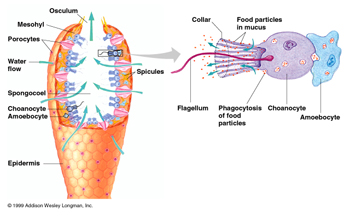The sponge has no nervous system, digestive system, or circulatory system. Instead, most people rely on maintaining a constant flow of water through their bodies to get food and oxygen and get rid of waste products. The sponge has no actual circulatory system. The sponge has flagellar cells on the surface of the body. These are cells whose tails sway. The collective effort of all these cells creates a stream of water through the many porous openings in the sponge body. This is a water-based circulatory system. In summary, sponges (or sponges) do not have a true circulatory system like most animals. There are no hearts, veins, arteries, and no blood on the sponge. Water is drawn into the sponge through the inner choanocytes, and the inner choanocytes take up water from the outer pores of the sponge. Click to see the full answer. Sponge has three basic body plans: (1) Asconoid sponge is a small and simple shape with a tubular body. (2) The ciconoid sponge also has a highly folded tubular body in a series of inflow canals that carry water into a radial canal lined with choanocytes, with much thicker walls.
thecircleofblood.weebly.com Изображение: thecircleofblood .weebly.com In summary, sponges (or polyferrans) do not have a true circulatory system like most animals. There are no hearts, veins, arteries, and no blood on the sponge. However, they achieve gas exchange and nutrient consumption through the movement of water. Click to see full answer
How does the circulatory system work with a sponge?
The sponge does not have a true circulatory system, but running water is used instead. The gas is carried into the cell by electric current and enters the cell by diffusion. Archaea supply nutrients.
Is the sponge a heart?
There is no heart, no veins, no arteries, and no blood on the sponge. However, they achieve gas exchange and nutrient consumption through the movement of water. Water is drawn into the sponge through the inner choanocytes, and the inner choanocytes take up water from the outer pores of the sponge.
Does the sponge have a nervous system?
The sponge has no nervous system, digestive system, or circulatory system. Instead, most people rely on maintaining a constant flow of water through their bodies to get food and oxygen and get rid of waste products. The sponge has flagellar cells on the surface of the body.
Is the sponge body plan simple?
The body plan of the sponge is simple. Unlike many animals, they do not have the nervous system, muscular system, or even the true circulatory system. Sponge body plan. There are several types of sponge body plans, each with a hollow body cavity, or sponge coil (SPUN-geo-seel), through which water and particles circulate.
What kind of circulatory system does a sponge have?
In summary, sponges (or sponges) do not have a true circulatory system like most animals. There are no hearts, veins, arteries, and no blood on the sponge. However, they achieve gas exchange and nutrient consumption by the movement of water.
Which of the following is correct for sponges?
The correct thing about sponges is: c) The sponge has no real tissue. A sponge is a very primitive organism made of cells, which are the cells.
Does the sponge have a special circulatory system?
The sponge does not have a complex digestive system, respiratory system, circulatory system, reproductive system, or nervous system.
Why doesn't the sponge need a cardiovascular system?
The simplest animals (rotifers) such as sponges and rotifers, diffusion allows proper exchange of water, nutrients, waste, and dissolved gas, so no circulatory system is needed. .. .. Instead, gas, nutrients and waste are exchanged by diffusion.

Below you will find two helpful answers on a similar topic. 👇
What is the normal blood pressure of a giraffe?Is your pet's blood pressure high?
